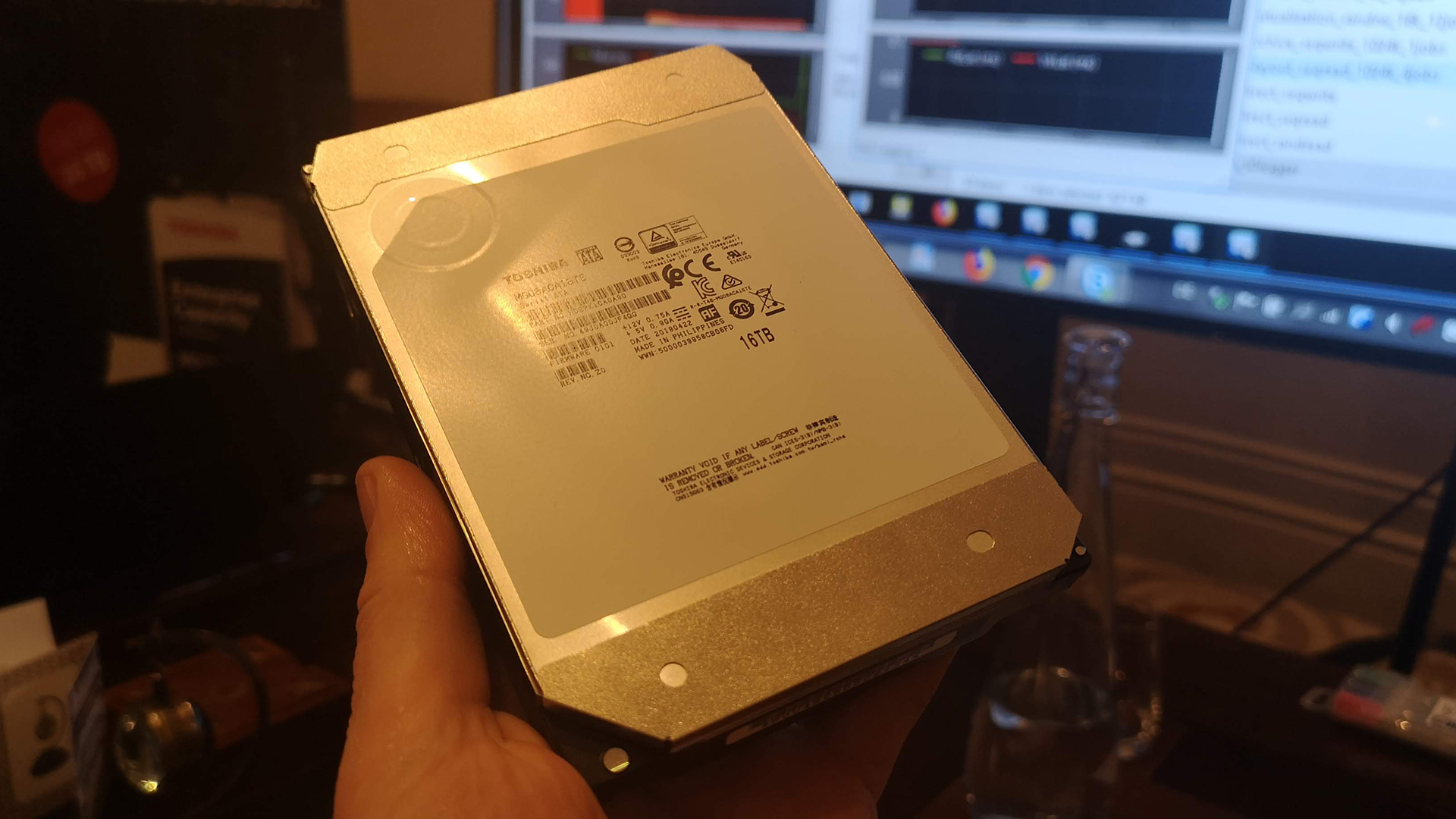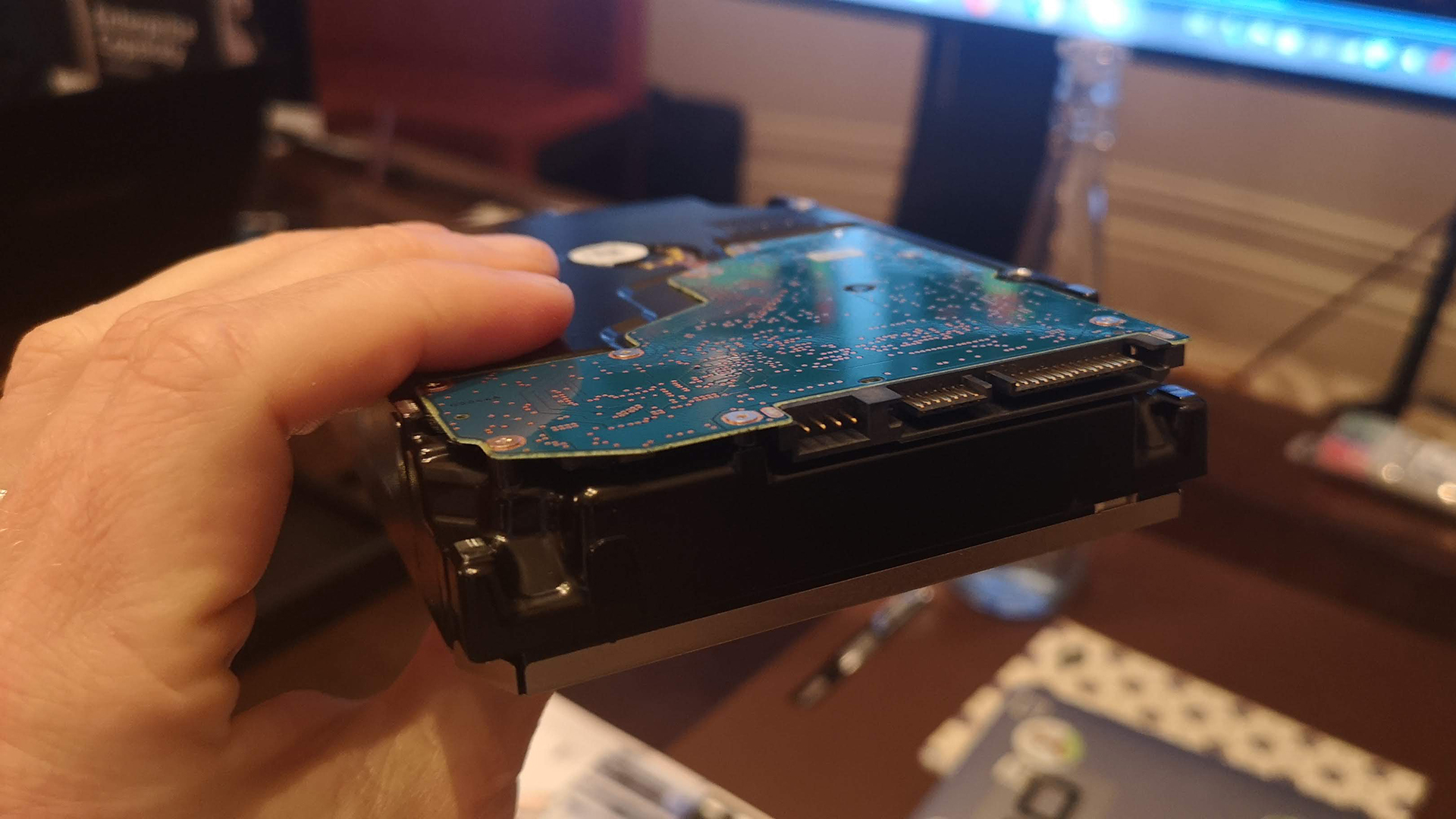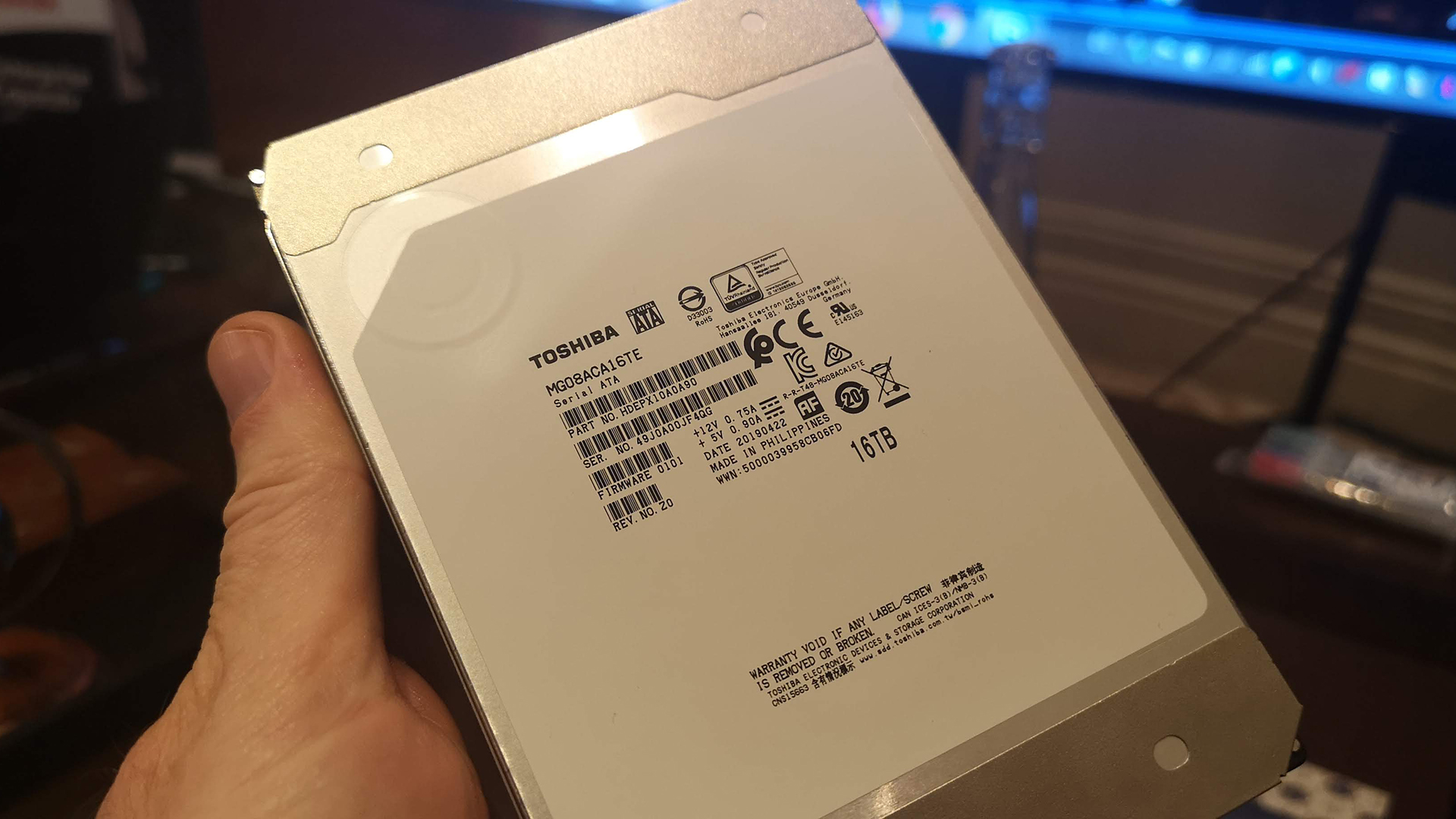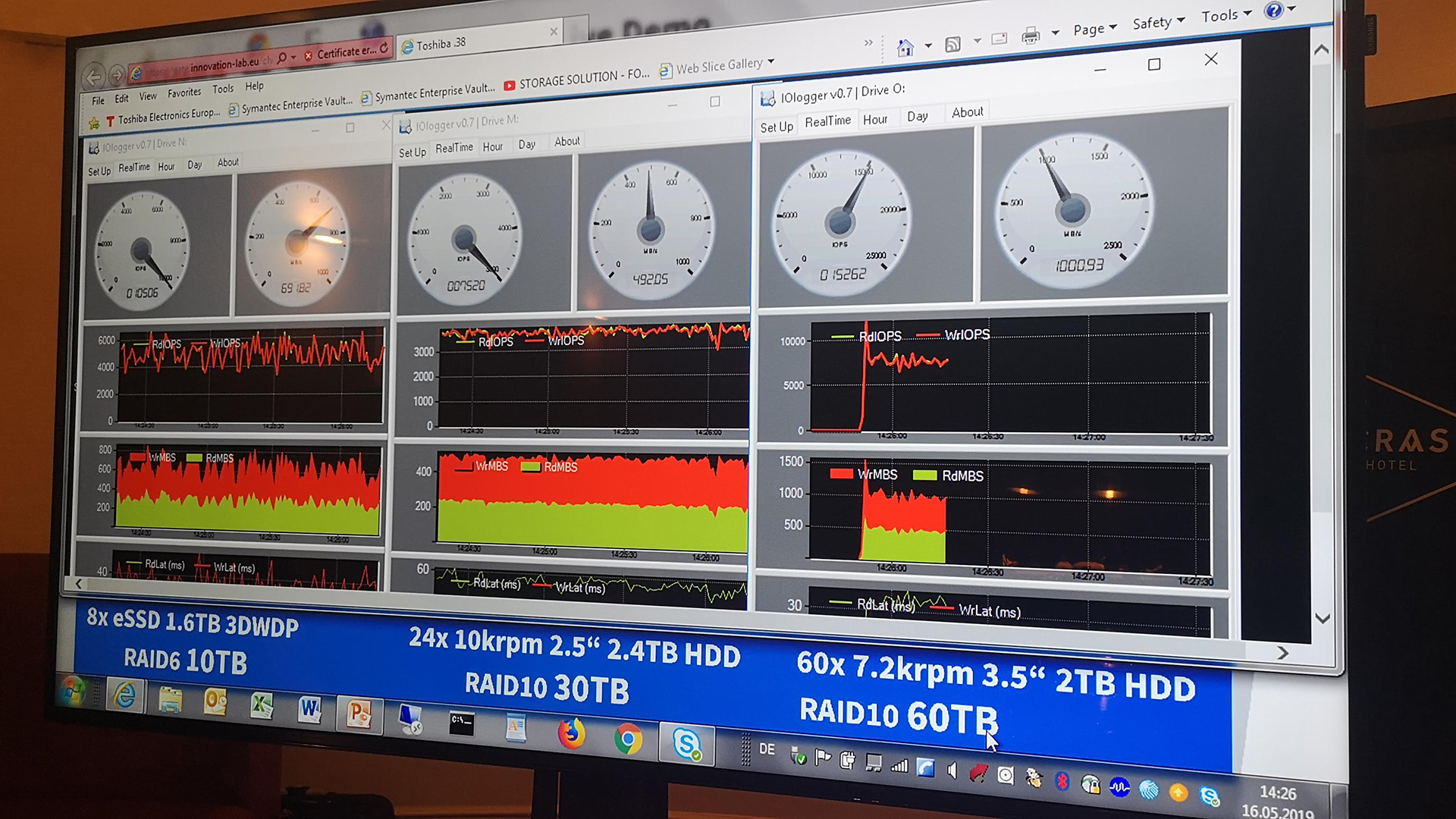Close encounter with a 16TB HDD: Meet the Toshiba MG08 HDD
A huge jump in storage in a familiar form factor

Toshiba is one of the three big suppliers of hard disc drives left in the business which is predicted to still account for a whopping 59 percent of storage in 2025. Spinning disc drives, in the right configuration, still provide one of the most cost effective and reliable performances for storage, after tape. The latest Toshiba MG08 CMR HDD takes this to a new level.
These drives, despite their huge capacity are still more affordable than Solid State Drives and are predicted to remain that way at least until 2025. They will be well needed then as the advent of widespread artificial intelligence, autonomous cars and 5G infrastructure will mean there is more data being stored than ever before. We're currently limited to the speed of fingers tapping and typing data into reality, once machines are creating their own data on a massive scale that input rate will jump hugely.
There were a mind boggling 33 million zetabytes stored per year in 2018 but thanks to the expected jump coming soon, 175 ZB are predicted to be needed per year as soon as 2025.
- Toshiba rebrands US and EU business
- How to wipe a hard drive in Windows 10 and macOS
- You will be able to buy a 20TB hard drive in 2020

Spinning up space
At 16GB, this is the largest capacity CMR (conventional magnetic recording) HDD that's out there right now, says Toshiba. This is achieved thanks to a new level of design smarts. Until now the capacity of the hard disc drive was limited by a number of factors: the number of spinning discs that can be crammed into the drive body with the amount of heads reading those discs, and the data recording density one each of these disks, being the two most major.

The new MG08 CMR HDD, available is SASS and SATA, crams in nine spinning discs and 18 heads to read said layers. That's supported by a new 512MB cache to keep everything running smoothly. This all fits into a standard 3.5-inch disc thanks to the laser welding technique – nabbed from the battery sealing department – which allows for a helium filling to give the discs space to float and spin freely.

Another key to all this extra storage is the feature of 1.78GB capacity per platter, a jump up from 1.5GB using TDMR (two-dimensional magnetic recording). This is achieved by using dual heads which allow for a more accurate pick-up of tracks, meaning they can be thinner without neighboring track data causing interference. It also means the capacity can jump up without incurring a greater use of overall space for power consumption. As a result, this drive can be swapped out for smaller older ones in the usual rackspace nice and easily.

Speed reading
To put into perspective just how much data is crammed onto this drive we need to scale up. Then to understand how accurate the reading process is we need to see how the reading head moves, close to the drive but without touching the plate. At the micro scale, which this head reads at, the flat-to-the-naked-eye disc looks like an undulating hilly landscape.
Sign up to the TechRadar Pro newsletter to get all the top news, opinion, features and guidance your business needs to succeed!
A 1TB drive unwound would stretch to 0.6 miles. Reading or writing that takes about an hour when moving at the 5 nm scale. When you scale that up by a factor of 1,000 you get 5 micrometres which is about a tenth of a human hair. So that's 600 miles of data unwound when stretched out. That's the equivalent of flying London to Munich in one hour at 600 mph. But it's done at surface level – at the height of a blade of grass – dodging mountains and forests on the way.
It manages this feat of dodging and accuracy thanks to a kind of spoiler on the reading and writing head that points it up and down as the magnetic field varies. The drive achieves 275 MB/s over the previous gen which topped out at 262 MB/s, despite this new unit having greater capacity and similar spin speeds (7200RPM)

Reinforced reliability
For enterprise systems the reliability of these drives is of paramount importance. That's why the failure rate needs to be kept low. In the case of the MG08 it's an impressive 2.5 million hours Mean time to failure (MTTF) equivalent to a 0.35% low annualized failure rate.
These drives spend weeks, or even months, on the testing machines so any helium leak could be spotted. In the real-world situation of a server room, even if mechanical stress resulting from vibrations or fans is whacking the drive daily it may only form a micro crack after years. A helium sensor will then detect any leakage and the drive will keep working even when some helium has leaked. It will continue to work at high efficiency until a 75 percent leak, which is when it will still work but performance will start to drop, so that's when it will need to be replaced.
So despite the jump in storage, reliability has stayed the same with 10 non-correctable read errors per 10 to the power of 16 bits read, and a MTTF of 2.5 million (drive-) hours. That means that you would have to run a population of 2.5 Millon drives to encounter a failure every hour. As a more realistic view, on 1,000 drives, every 104 days a failure is expected. That's an annual failure rate 0.35 percent but in the real world – even at installation where Toshiba is sure that every failing drives is registered - that is seen as half that.

Energy efficiency is also at its best now. Power consumption improvements have been made on the 7,200 rpm drive which for long time was 7W in standby and 11W reading and writing regardless of the capacity. This was in air. Now, using helium there is less resistance to the spinning disks so power is down to 4W in Standby to around 7W in operation.
This means that the new, larger capacity drives can be swapped out in rackspace for older drives to not only improve performance but to drastically improve power consumption. When you consider the need for fewer drives you not only save money on power consumption but also on cooling costs as fewer racks can be needed overall.

Real-world tested
When used in real-world scenarios the HDDs are able to offer similar, if not better, performance on a large scale than SSDs for the same money or less. Check out the image to see the difference. For the money available there is an SSD setup, on the left, showing the performance of eight SSD in RAID6 configuration with a total of 10TB storage. In the center, for that money, you get 24 10krpm hard disc drives in RAID10, giving 30TB storage. On the right, for that price, is a setup of 60 slower 7.2kprm drives, again in RAID10, with 60TB of space.
The IOPS (input/output operations per second) score can be seen as 10,506 on the SSD, a lower 7,520 on the middle setup but an impressive 15,262 on the slowest drives setup on a larger scale to the right.
Future Toshiba HDD tech
Based on this jump Toshiba is looking at how to scale further in the future. This new tech has allowed for the commonly bought affordable 4TB drive to get a redesign with three platters where there were previously four or five. This should mean an even more affordable drive and this is due to launch in the third quarter of 2019.
Looking further ahead to 2020, an 18TB SMR (shingled magnetic recording) drive is planned. While this will offer excellent capacity, it does mean a total rewrite each time changes are made due to overlapping tracks. So this will likely be a longer term archiving storage solution due to lower right speeds
Also, by 2020 the next generation (MG09) could use MAMR (microwave assisted magnetic recording) to increase storage capacity to 18TB without the restrictions of SMR. Toshiba is also looking into the alternative HAMR (laser assisted magnetic recording) but this is less viable in the short term, working better for over 30TB capacity, so may be something it uses further down the line when the laser efficiency and reliability is better.
- We've also highlighted the best hard drives of 2019
Luke is a freelance writer and editor with over two decades of experience covering tech, science and health. Among many others he writes across Future titles covering health tech, software and apps, VPNs, TV, audio, smart home, antivirus, broadband, smartphones, cars and plenty more. He also likes to climb mountains, swim outside and contort his body into silly positions while breathing as calmly as possible.
